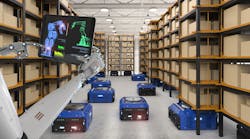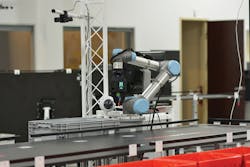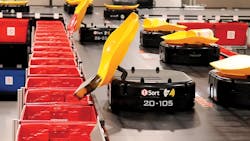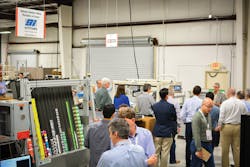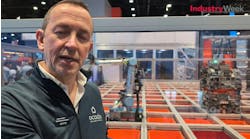Longer onboarding and training, rising benefit and compensation rates, and shortages in labor are driving more and more warehousing, distribution and fulfillment facilities to invest in automated solutions for operations. As the technologies improve and the applications become wider and more flexible, robotics are being adopted by a greater number of warehouse operations throughout the U.S.
Companies have found that the lower cost of capital, faster ROI and modularity of automation through robotics offer a renewed opportunity to make incremental investments that can be recouped in a reasonable amount of time. In addition, companies can buy what they need as volumes dictate and build capabilities, as opposed to a significant upfront capital investment. Modularity of the robotic systems is a key selling point for all automation manufacturers. Especially in retail and e-commerce, demand is highly cyclical, requiring solutions that are flexible enough to be set up and taken down easily.
The industries currently the most intent on using robotics in warehouse operations are store fulfillment for retail applications and in e-commerce fulfillment. E-commerce operations use robotics for goods-to-person picking, collaborative picker aids and sortation systems. The flexibility of the systems lend themselves to be used across a wide product type, including apparel, beauty aids, health products, pharmaceuticals and consumer goods. Robotics such as automated guided vehicles (AGVs) and palletizers and depalletizers have been available for many years and are used in a wide range of industries, such as grocery, automotive and pharmaceuticals.
Goods-to-person picking robotics are used in e-commerce fulfillment. Goods-to-person robots allow the warehouse associate to remain at a packing station, while the goods are brought to them for packing and shipping. One of the best-known goods-to-person robot companies is Amazon Robotics (formerly Kiva), which only sells to Amazon. It is currently estimated that Amazon has over 45,000 robots in operation in over 320 warehouses throughout the U.S., which is believed to be the largest installation of robots in the country.
Swisslog’s CarryPick is a similar technology. The system has been adopted by DB Schenker, a major third-party logistics provider (3PL), and has 65 units installed at Lekmer’s e-commerce facility in Sweden. Lekmer is a manufacturer of children’s products.
Robotics used as collaborative picker aids are predominately used in e-commerce fulfillment. Collaborative picker aids use robots that travel the warehouse, stopping at a location where an item needs to be picked. Warehouse associates look for robots with green lights, which indicates an item needs to be manually picked and placed from a storage bin into robot bin. When the order is complete the robot goes to a packing operation.
A technology from Locus Robotics uses an approach to e-commerce fulfillment operations using an autonomous mobile robot (AMR). AMRs are robots that can move independently, by navigating using sensors and cameras. Locus is a spinoff of Quiet Logistics that decided to build its own robots after the Amazon Kiva deal in 2012. Quiet Logistics primarily serves the apparel industry and customers such as Zara, Bonobos,and Bluefly.
Growing Confidence in Robotics
Venture capitalists are confident in robotics technology. For instance, Locus raised $25 million in 2017, bringing its total funding to more than $33 million. In 2017, 6 River Systems Inc., a robotics company founded by ex-Kiva executives, received $15 million of venture capital. China warehouse robotics startup Geek+, which boasts Alibaba as a customer, raised $22 million, and RightHand Robotics added $8 million in venture funding.
Robots used in sortation applications are increasingly being used for retail, wholesale and e-commerce fulfillment operations. The types of facilities include parcel sortation, distribution and fulfillment centers. One of the newest technologies on the market are robots for unit and parcel sortation. Fortune 500 companies are testing this robotic sorting technology in warehouse operations throughout the U.S. to increase efficiency and reduce cost.
t-Sort, an AMR material handling system created by Lab Z, has applications for both unit and parcel sortation. In fact, the t-Sort can perform unit and parcel sortation simultaneously. It has a highly modular design that is easily expandable; more robots and sortation destinations can be added as needed. The primary applications for t-Sort include e-commerce, retail store replenishment and wholesale orders to distributors.
The Opex Sure Sort robot is a different technology and is used for store replenishment and picking direct-to-consumer orders. Replenishment and wave or batch picked orders are delivered to a Sure Sort induction operator located at a workstation. Items are placed on a drop conveyor and scanned. A waiting iBOT delivers the item to a designated order bin located on either side of a storage aisle. Sure Sort delivers all items to their assigned order locations.
A portable high-speed order fulfillment system from Mobile-Matic can be used for pick and convey operations. The Mobile-Matic A-Frame system is designed for e-commerce fulfillment centers with order-picking applications that experience spikes in demand, have a small number of very fast-moving SKUs, or have a large number of one to three line orders. The system relieves pressure from manual and automated picking operations by eliminating the need to re-slot additional lanes of SKUs to accommodate increased demand. The Mobile-Matic system is a simple “out-of-the-box” solution and can work with any conveyor specifications. Warehouse associates can unpack the system, roll it up to the conveyor, and connect power and network cabling. The system is modular in design and one primary unit controls up to three additional secondary units.
An AGV is a portable robot that follows markers or wires on the floor, or uses vision, magnets, or lasers for navigation. AGVs have been used for case, pallet, bulk, or specialized container movement for many years across a wide range of industries and applications. AGV systems with several hundred machines can be found in the automotive industry, and industries with high-value goods, such as pharma. Warehouses with 30,000 to 50,000 pallets derive the greatest benefit from AGVs. The cost implications depend on the tasks to be automated, as well as scale.
Palletizers and depalletizers are a type of robot automation used in production and warehousing. Palletizers are used in production applications for building pallets of finished product and building pallets for store replenishment. They are often used in the food and beverage industry. Approximately 80% of depalletizer applications are used in the warehousing industry. Depalletizers are used in induction spaces within a variety of industries. Depalletizers are the most efficient when similar sized cases are on the pallet.
C&S Wholesaler Grocers’ dry goods warehouse has adopted a “lights-out” distribution center. Robots depalletize pallets layer by layer and load in single case quantities onto a conveyor to an automatic retrieval and storage system. As orders for cases are received, product is retrieved by robots and conveyed to another set of robots that builds the order for the store. This operation runs on average 21 hours per day, seven days per week.
More Efficient Warehousing
Robotics and automation will increasingly be used in warehouses as a means to decrease reliance on manual labor, reduce picking errors and improve efficiencies. The retail industry in particular derives the majority of its revenue in the last four months of a year. The new systems are scalable. The scalability and quick implementation schedules for these systems mean that the cost reduction benefit can be seen in just a few months at a fraction of the initial investment of the traditional fixed-path systems.
Also driving robot usage is the growth in e-commerce sales that requires each picking. Total e-commerce sales for 2017 were $453.5 billion, an increase of 16.0% from 2016. E-commerce sales in 2017 accounted for 8.9% of total sales versus 8.0% of total sales in 2016 (U.S. Department of Commerce). Venture capitalists are confident in the development of the technology and have invested millions of dollars in start-up robotics companies. These cost-effective solutions will soon be mainstay in many warehouse operations.
Mike Futch is president of Tompkins Robotics, which is the exclusive U.S. distributor of the t-sort AGV.
